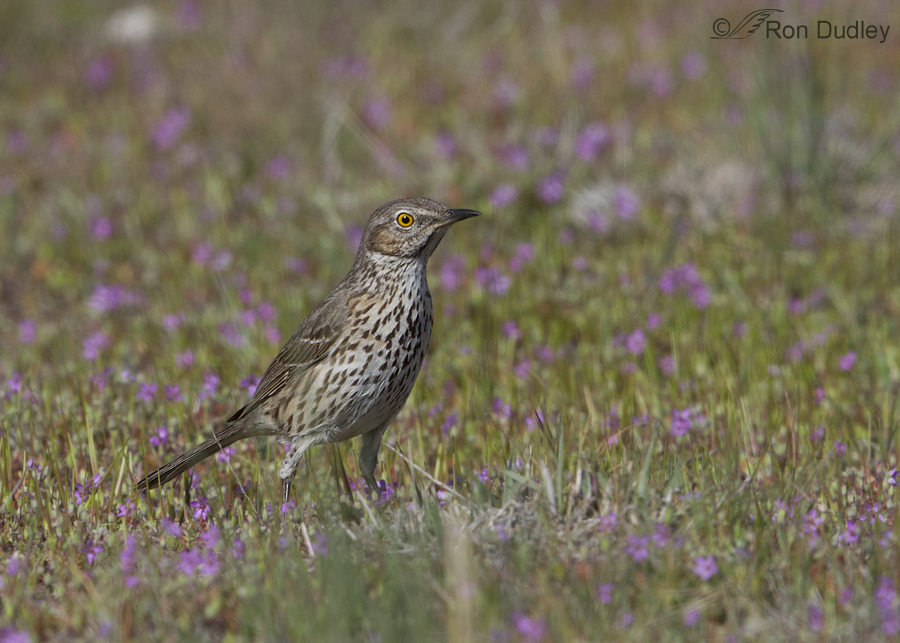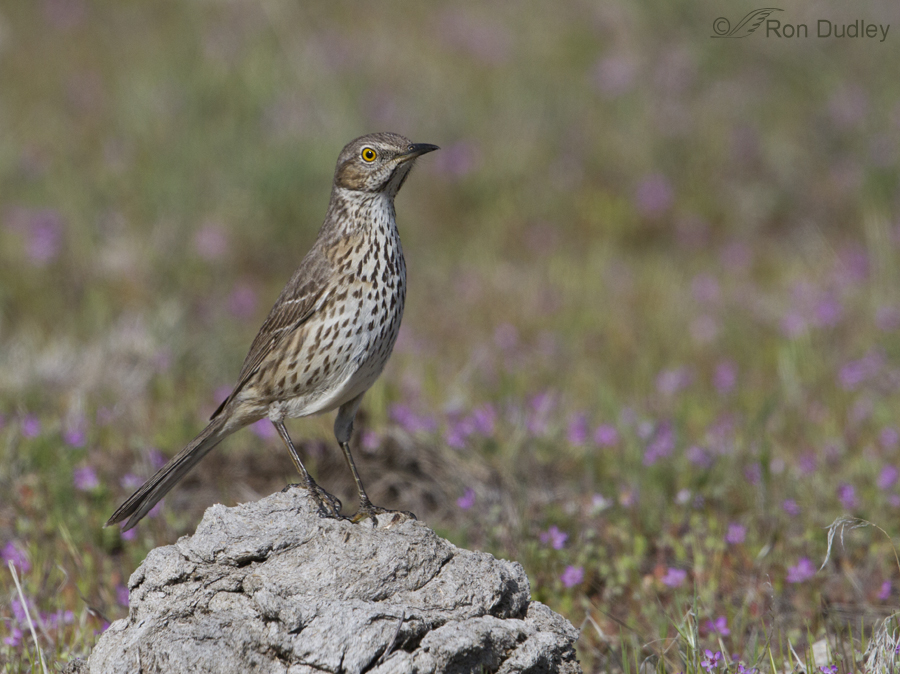Most of my photos of Sage Thrashers show them on elevated perches so I appreciate the variety when I can catch one on the ground in a flowery setting.

1/4000, f/8, ISO 500, Canon 7D, Canon EF500mm f/4L IS II USM +1.4 tc, not baited, set up or called in
In some areas of the island Redstem Filaree is blooming profusely right now. The flowers don’t open until the sun’s been up for a while and I’m usually on the island at sunrise so the timing was good when I found this thrasher later in the morning five days ago as it foraged for insects. I took a few shots of this bird among the flowers but then it must have decided that it was tired of all the clicking and that huge metal “eye” being pointed at it so…

1/4000, f/8, ISO 500, Canon 7D, Canon EF500mm f/4L IS II USM +1.4 tc, not baited, set up or called in
it hopped up onto this large, ugly and very old “buffalo chip” (bison poop) and almost dared me to continue taking its picture. I obliged the bird.
Actually I enjoy buffalo chip perches and will photograph a bird on one at every opportunity. I think it’s because of my intense interest in western and Mormon history combined with my fascination with birds. My great-great grandfather Oliver Hunt Dudley and his family were Mormon pioneers (no, I’m not Mormon) who crossed the plains to follow Brigham Young to “Utah” (Mexican territory back then) in 1850. I have old letters and other records that document their trip across the plains and Rocky Mountains and their difficult life after they arrived here. Like other pioneers, during their arduous and treacherous trek they relied on buffalo chips to fuel their campfires when firewood wasn’t available, which was often the case.
It’s probably a huge stretch to say that I owe my very existence to bison poop. But then again, maybe not…
Ron


Looks to me like that bird was definitely daring you to photograph it! Love these photos.
Enjoy the close-ups of the thrasher as well as the comments today.
Aunt Sadie traveled west. By covered wagon, ended up living in a sod hut…buffalo chips were a very important source of fuel, providing heat and saving lives of many…after all, they’re not much more than “processed” vegetation, mostly grass. As one of the younger members of her family, she was often one of the ones expected to collect and pile these precious “frisbees”. No one thought anything about it…except gratitude for its abundance…now, if Buffalo’s had been carnivores…..that might have raised a big stink!
Love the sage thrusher and the Island Redstem Filaree. And then my mind started wandering…
Cow manure is still perhaps the most common fuel in a lot of India. A life saver – and no I don’t think your mind stretched too far. And then I wandered some more. My brothers used to ‘mine’ cow manure (preferably reasonably fresh) with bungers (fire crackers). If they had judged correctly the fallout was truly impressive. And, to this day, many years later I still cast a weather eye at cow pats to see just what is on it/in it…
Thanks so much for enriching these wonderful photos with your family history. It took a lot of grit (and the right kind of poop, I see) to make it out in the frontier. You have clearly inherited much of the pluck and focus!
Great pic, especially when Helena, MT can’t seem to shake the winter – snow early last week then cold rain Saturday and Sunday. Sun today but still cold and blowy. Great view of the bird, but in this case I appreciate the flower background just as much. Your pictures are a great start to my day.
Also, we who love “nature” sometimes, in our nostalgia and romanticism, forget or ignore how down, dirty and dangerous it still can be, especially if we can’t get back to our fleece-lined or down jackets, our car, a warm house or camper and the food in our refrigerator. Our ancestors, however many generations back, had a different sort of respect and awe for their environment. If they didn’t, they didn’t survive.
Those ancestors also must have had a deeper sense of vulnerability to illness and accident. Whether we are in denial or not, we think every medical problem can be “fixed” and sometimes feel cheated when that is not so. Our predecessors’ examples of hard work, persistence and hopefulfulness in the face of adversity are wonderful encouragements.
Thanks again for both the pics and the comments. I am going to forward this one to some friends.
Ed
Thanks for the Montana weather report, Ed. I’m hoping to make it up there soon but don’t want to go while there’s still snow.
And you’re absolutely right. The difficulties those old timers faced back then are hard for us to even imagine today. The reality of it all was often very cruel by the standards of today.
Thanks for sharing with us that bit of your family story.
I would never guess that I would be grateful to buffalo poops in order to learn some of your photographic skills.
Loved your last sentence, Jorge – made me smile.
I love your scholarly approach to history… Much in our lives stems from such fulsome details! Wonderful story and photos.
Thanks very much, Deborah.
Nice shots … and as a family historian and researcher, I’m fascinated to learn your ancestors were among the notable families who crossed with Brigham Young. What a treasure you have in those old letters. I came across a family trunk, letters including, dating back to 1827 Virginia in my own research. Although we must be content to “see” the land through their words … how wonderful it would have been if they had had cameras! I am sure your ancestors would be pleased to know that you love the land and have such great appreciation of nature.
Thanks, Patricia. My ancestors didn’t actually “cross with Brigham Young” – originally they were going to but since he was a shoemaker Brigham asked Oliver to stay back for a while and make shoes for others before they crossed. Brigham came to Utah in 1947, Oliver and family came three years later in 1850. I can imagine how thrilled you must be with your family letters from 1827!
Great shots Ron, thanks for sharing!
Charlotte Norton
Thanks, Charlotte.
Great set Ron! Initially I’ve read so much about the use of Buffalo Chips by the early pioneers, didn’t think anything about it, but then I laughed out loud to your last comment!
I don’t think it is that much of a stretch, considering what they had to go through and if they didn’t survive you wouldn’t be here in your present form!! VBG Thus it would have been our loss!
Thanks, Dick. Honestly, I don’t think it’s that much of a stretch either. Both Oliver and his wife Mary Ann very nearly died during the trip. They were very sick for months from “mountain fever” (actually Colorado Tick Fever). They spent most of their time in the back of the wagon on their sickbed as their 15 year old daughter (also named Mary Ann) drove the wagon over half way from Council Bluffs, Iowa to Utah in 1850 (the wagon was hitched to an old cow and an ox). The warmth and comfort from buffalo chip campfires at night could very well have made a difference in the survival of either or both Oliver or Mary Ann. At least that’s my way of thinking.
Thank goodness for buffalo poop!